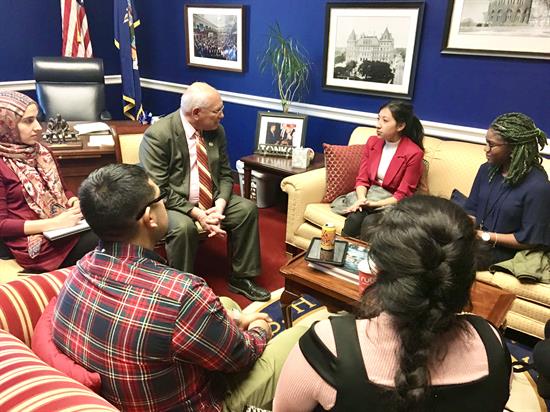- Home
- About
-
Constituent Services
- Academy Nominations
- Community Project Funding
- Congressional Art Competition
- Congressional App Challenge
- Congressional Commendation
- Event Invitation
- Grants
- Help with a Federal Agency
- Internships
- IRA Clean Energy Consumer Benefits
- Know Your Rights: Immigration
- Request a Meeting
- Request Surplus Books
- Presidential Greeting
- Visit Washington D.C.
- Issues & Legislation
- News
- 20th District
- Contact

Press Releases
Tonko Presses USDA on Unfair Distribution of COVID Aid for Capital Region FarmsCalls out skewed funding criteria that favored row crop operations in Midwest and elsewhere, shortchanging smaller & specialty crop farms more common in Upstate New York
Amsterdam,
March 24, 2021
Tags:
Agriculture
AMSTERDAM, NY—Congressman Paul D. Tonko is calling on U.S. Department of Agriculture Secretary Tom Vilsack to explain why disproportionate amounts of federal COVID funding went to large farms in the Midwest and elsewhere with a greater focus on row crops, reducing the Coronavirus Food Assistance Program (CFAP) funding available to other types of agricultural operations including the family farms and specialty crop growers more common in New York’s Capital Region. “This funding was urgently needed by farmers producing virtually all commodities across the country,” Tonko writes in a letter to the USDA secretary. “CFAP funding was not distributed evenly. The first round of CFAP program funding, totaling over $10 billion dollars of distributed funds, were heavily concentrated in the Corn Belt, Texas, and California and went primarily to row crops…. [M]arket prices for most acreage-based commodities have recovered substantially since mid-2020. In contrast, specialty crops, a major agricultural sector in my district, have received disproportionately less funding.” Tonko’s letter calls out several related issues worsening the already unfair treatment of small and specialty crop farms in New York and elsewhere:
Full text of Congressman Tonko’s letter: The Honorable Thomas J. Vilsack Secretary United States Department of Agriculture 1400 Independence Ave., SW Washington, D.C. 20250
Dear Secretary Vilsack, As the Representative of New York’s Capital Region, I represent a diverse community of farmers. Farmers in my district along with those across the country have suffered significant losses due to the Coronavirus pandemic. As you know, the pandemic caused demand shocks that were felt throughout the entire agricultural supply chain starting with the farmers. The widespread shutdown of major food purchasers, including schools and restaurants, and the shift to home consumption drove farmers to be left with unmarketable surpluses of goods and retailers with supply shortages. The New York dairy industry is no exception, with over 4,000 dairy farms in New York it is one of the largest agricultural commodities. We have heard directly from farmers across the district about the struggles they face as a result of the pandemic. Due to shifts in demand dairy farmers in my district have been forced to “dump” significant quantities of milk, resulting in major losses of both money and nutrients. As you know, the goal of the Coronavirus Food Assistance Program (CFAP) was to provide direct relief to producers whose supply chains were disrupted by the COVID-19 pandemic. This crisis required rapid distribution of funds and I recognize the United States Department of Agriculture’s (USDA) work to take swift action. This funding was urgently needed by farmers producing virtually all commodities across the country. However, CFAP funding was not distributed evenly. The first round of CFAP program funding, totaling over $10 billion dollars of distributed funds, were heavily concentrated in the Corn Belt, Texas, and California and went primarily to row crops. I recognize USDA attempted to address this issue by expanding eligibility for the second round of CFAP funding, however, there was still a disproportionate amount of payments distributed to row crops when referencing production value. As of March 14th, 2021 $13.3 billion dollars were distributed overall under the second round of CFAP, 47 percent going to acreage based agriculture. The cited Congressional Research Service report also notes that market prices for most acreage-based commodities have recovered substantially since mid-2020. In contrast, specialty crops, a major agricultural sector in my district have received disproportionately less funding. I understand that CFAP payments needed to be distributed rapidly, but it is paramount that farmers are compensated equitably for their economic hardship, whether that is from the COVID-19 crisis or a future crisis. That is why I am asking for USDA to consider the following questions: 1. What factors influenced the types of producers that were awarded more funding? What factors influenced the types of producers that received less funding? 2. What barriers existed to producers in applying for program benefits? 3. In future awards, how can the process be structured to more equitably distribute funds to the full range of producers? What steps does USDA anticipate taking to ensure that specialty crops and other non-traditional commodities are included more equitably in future disaster assistance programs? 4. How much in taxes were CFAP recipients required to pay in 2020? What percentage of funding received does that represent? 5. Are there any considerations you would like to share that Congress can make in creating future grants and funding opportunities for farmers? Thank you for your attention and taking time to consider these questions we look forward to working with you.
Sincerely, Paul D. Tonko Member of Congress
|
